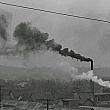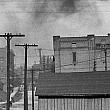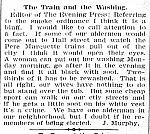
Ringelmann Smoke Charts
While Louis Towner does not mention the Ringelmann charts in his reports, it is likely that he did use them. They are included in a 1928 display by the Bureau of Smoke Inspection,
The Ringelmann Smoke Chart, giving shades of gray by which the density of columns of smoke rising from stacks may be compared, was developed by Professor Maximilian Ringelmann of Paris. Ringelmann, born in 1861, was professor of agricultural engineering at l'Institute National Agronomique and Director de la Station d'Essais de Machines in Paris in 1888, and held those positions for many years thereafter.
The chart apparently was introduced into the United States by William Kent in an article published in Engineering News of November 11, 1897, with a comment that he had learned of it in a private communication from a Bryan Donkin of London. It was said to have come into somewhat extensive use in Europe by that time. Kent proposed in 1899 that it be accepted as the standard measure of smoke density in the standard code for power-plant testing that was being formulated by the American Society of Mechanical Engineers.
While the Ringelmann Smoke Chart has many limitations, it gives good practical results in the hands of well-trained operators. However, it is questionable whether results should be expressed in fractional units because of variations in physical conditions and in the judgement of the observers.
 To use the chart, it is supported on a level with the eye, at such a distance from the observer that the lines on the chart merge into shades of gray, and as nearly as possible in line with the stack. The observer glances from the smoke, as it issues from the stack, to the chart and notes the number of the chart most nearly corresponding with the shade of the smoke, then records this number with the time of observation. A clear stack is recorded as No. 0, and 100 percent black smoke as No. 5.
To use the chart, it is supported on a level with the eye, at such a distance from the observer that the lines on the chart merge into shades of gray, and as nearly as possible in line with the stack. The observer glances from the smoke, as it issues from the stack, to the chart and notes the number of the chart most nearly corresponding with the shade of the smoke, then records this number with the time of observation. A clear stack is recorded as No. 0, and 100 percent black smoke as No. 5.
More information about the Ringelmann Smoke Chart is available here.

 facebook
facebook








